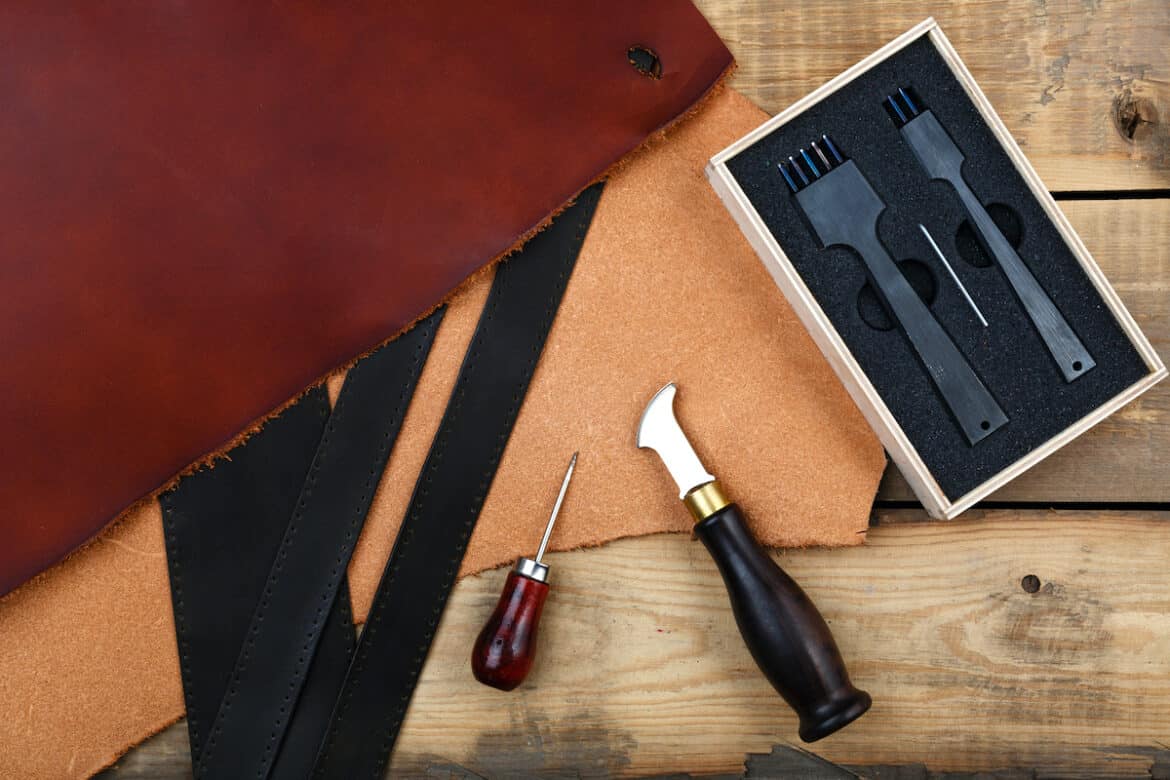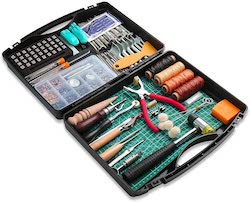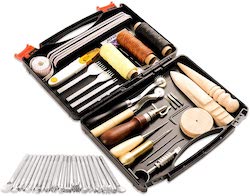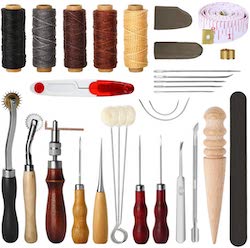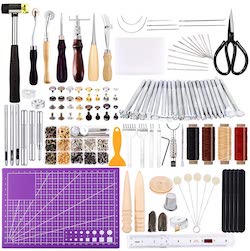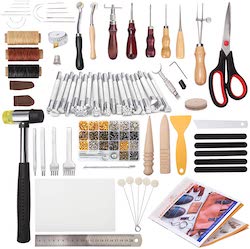Leather has over time gained popularity in many industries and has seemingly proven sustainable. Since time immemorial, leather has played an integral role in shaping up the fashion industry, creating a world that dons leather shoes, bags, clothes, and accessories.
The demand for leather items has ostensibly increased, something attributed to its intrinsic features. If you are a beginner just delving into leatherworking, then you must have the right set of tools to accompany your skills.
There is a myriad of tools out there, and it gets not only confusing but also expensive to buy every piece individually. A leatherworking kit is the easiest way for any beginner to get started in leatherworking.
So what are the best leatherworking kits for beginners? The best leatherworking kits for beginners are those that contain all the essential tools for basic leatherwork, including measuring, cutting, and joining tools. A good kit also has well-constructed tools and is both simple but comprehensive enough for the absolute beginner.
However, having the best leatherworking kit in your hands alone is not enough. You must be able to use it effectively too. So, to help you sail smoothly, we’ve put together this beginner guide on how to get started in leatherworking.
Here you will learn about the necessary tools in a basic leatherworking kit and how to use them. We also rank and review the 5 best leatherworking kits out there to lighten your purchasing decision. Let’s dive in.
How to Get Started in Leatherworking
For a long time, the leather industry has been associated with the large-scale production of high-end items. Think high fashion handbags and luxurious seats.
Today, working with leather has also become a more straightforward DIY kind of thing thanks to the availability of the various handling tools. It is now available to serious professionals and crafters alike.
But to begin any leatherworking project, you must possess the basic skills, tools, and materials for the job.
The very first step, is deciding on the project itself, so you know which skills, tools and materials to pick up! As a beginner, it is best to go small and simple at first so you can utilize the most basic skills to finish the job more swiftly and easily. Complex projects that need advanced skills may demoralize you too early.
What Can You Make With LeatherWorking?
You can make anything with leatherworking; it is all about creativity. Some popular leatherworking projects include earrings, bracelets, personalized key chains, knife sheaths, watch straps, belts, wallets, journal covers, all kinds of bags, portfolios, briefcases, sandals, saddles, seat covers, pet collars…to mention but a few!
Once you pick the leatherworking project you want to tackle first, you need to apply the skills needed to make it. If you haven’t already learned the basic leatherworking skills, you can join a leatherworking class or use the plenty of blogs and channels with tutorials for the same. Guide books like The Leatherworking Handbook are also a great resource.
You’ll only need to know how to measure, cut and punch holes in the leather, stitch work, and polishing off of the edges for simple projects. Stamping, tooling, lacing, and other decorative and detailing skills come in handy too at later stages.
Having the best leatherworking kits alone cannot guarantee a successful project, but understanding its components does. Knowing what tools you need and how they work is the most vital step of leatherworking for beginners, bringing us to the next question.
Essential Tools For Leatherworking
The most basic tools needed for leather-working are measuring, cutting, and sewing tools. With as little as a ruler, a cutter, leather needles, and thread, you are set to begin and can produce great results.
Conversely, you’ll need a lot more tools than these depending on the complexity of what you plan on making.
Here’s a comprehensive list of essential tools for basic leatherworking and a detailed explanation on how to use them.
Measuring Tools
A ruler is the most basic yet fundamental leatherworking tool, especially if you are not tracing an object’s outline. You’ll need to measure and mark the leather before proceeding to cut it.
For this job, you can use any of these:
- An ordinary ruler
- Measuring yardstick
- A flexible tape measure (not the retractable kind, which might spring back and snag your leather)
Simply lay your measuring device flat on the leather and use chalk, scratch awl, or pencil to draw a marking, or run a knife/blade alongside the edge to cut the leather.
A steel ruler with cork backing has the greatest advantage over other types of rulers. It is sturdier, and there are no chances of accidentally slicing tiny strips off the edges when using a knife. The backing also makes it non-slip, which is essential for getting the measurements right.
Leather Cutting Tools
The flexibility of leather aids in making several items of different shapes and sizes. You will need to alter the material by cutting it to size to achieve the form and scope equivalent to what is required for the item you are creating.
Among the various cutting tools available in the market, knives and blades are popular owing to their ability to cut through thick leather.
Some of the most readily available and reliable tools when it comes to cutting leather include:
- Utility knife
- X-Acto knife
- Leather scissors/sheers
- Rotary cutter
Other specialty cutters include a skiving knife, swivel knife, head knife, box cutter, bevel point knife, and more. You can save these for when your skill level has gone up a few notches higher.
Typically, the technique of using basic knives and blades is the same. You need to hold down the leather material with one hand and slowly but firmly pull the cutter along the marked lines.
To achieve a clean-cut, ensure to keep the knife at an angle and apply pressure enough to cut your way through without the need to go over it. For curved turns, move the leather instead of the blade.
Hole Marking and Punching Tools
Stitching is an integral part of leatherworking, and marking and making holes is the first step. Any advanced leatherworker needs relatively few tools to sew two pieces of leather together.
As long as you can mark and make holes vertically and evenly without any special tools, all that is necessary to stitch is
- Leather sewing needles (a set of straight and curved needles in a variety of lengths)
- Flat waxed lanyard
Fortunately for beginners and professionals, there are tools designed to ensure the stitching process is done neatly, effortlessly, and fast. Which ones are they?
Overstitch Wheel
This tool utilizes a serrated wheel to create dotted markings of uniform spacing on leather fabric. These impressions act as a guide for where to puncture holes in the leather.
An overstitch wheel’s spacing could be 2mm to 6mm apart or have interchangeable wheel. Roll it over in the desired direction while applying pressure to make evenly spaced vertical dots.
Awl
The versatility of an awl makes it is an indispensable leatherworking tool. In fact, it could be all you need when it comes to leather crafting.
This tool has a sharp point that widens up towards the grip. Though it comes in various tip shapes- rounded, hollow, hooked, etc.
You can apply the use of awls in the making of small holes and stitching scratch lines. Additionally, the tool is useful in hand stitching, where it is instrumental while trying to get the needle and thread past a tight stitch hole.
Another essential use of this magic tool is during the application of leather cement or glue, where it helps create adhesion on the surface of the leather by roughing it up.
To use an awl, firmly hold onto the wooden grip and press the sharp point to make a leather hole. Where the required spot is more extensive than what an awl can punch, its purpose would be to mark the holes’ locations.
Diamond Chisel
This is another must-have leatherworking tool used in stitching to ensure you make perfect and straight holes.
There are a various diamond chisels with one to enough prongs to punch over ten holes at once. Such a chisel is suitable for large-scale projects owing to the amount of time it will save.
The beneficial aspect of the diamond shaped chisel is its multi-purpose use beating the need for many tools. It marks, spaces evenly, and punches holes simultaneously.
Using a diamond chisel in punching holes is effortless. You only have to press down the tool in a straight line on the leather to make uniform holes. A non-metal head mallet comes in handy for gently tapping the diamond chisel when tackling thicker leather.
All you need to achieve any leather solution are simple tools such as the ones outlined above. They are practically all the basic leatherworking tools.
Fundamentally, they help you as a newbie shape your craftsmanship skills and acclimatize to ways of handling leather materials without massively investing in high-end leather tools.
Non-Essential, But Useful Leatherworking Tools
Notwithstanding, there are other non-essential yet good to have kind of tools. The ones that protect your hands, make your work easier, refine your finish, and gives your end product a professional and aesthetic edge.
These nonessential tools include:
Leather Tooling Stamps
These make interesting, beautiful, and personalized patterns or messages on tooling, carving, or veg-tanned leather. You’ll need a nonmetal head mallet to stamp the design on wet leather on a firm surface.
Burnishing Tools
Wood slicker burnishes are the most popular handheld burnishing tool. They polish rugged leather edges to be smooth and fine and eliminates chances of fraying. The tool works by the action of swiftly rubbing the slicker back and forth along the hairy edges.
They can come in plastic, brass or glass. Others are motorized attachments designed to fit in a dremel or other rotary tool.
Cutting Board
A cutting board or mat goes below the leather before cutting. It protects your work surface from getting damaged. The best cutting mats are self-healing. In addition, they are printed with grids to aid with measurements.
Stitching Grooves
This tool has a blade used to make grooves, so your stitches lay below the surface and are more durable and neat. To use it, adjust it to the desired width, lay the grooves on the edge at an angle and while pushing down, slide it towards yourself.
Wool Daubers
Wool daubers, also known as swabs or wool balls, are applicators with wire handles used during conditioning, polishing, or dyeing of leather for a mess-free job.
Thimble and Finger Cots
These are protective pieces worn on the fingers to safeguard from getting pricked by the tools. Such accidents are pretty common with beginners. The devices also help push or pull tools through thick leather painlessly.
5 Best Leatherworking Kits
Knowing the type of tools you need is the first step towards landing the best leatherworking kit. Nonetheless, there are other factors to consider when looking for a leatherworking tool kit.
Quality and craftsmanship, for example, are of utmost importance. So is the simplicity or comprehensiveness of the kit to your needs and skill level. You probably also have a budget in mind.
The hardest part about leatherworking is perhaps the start-up cost, as the tools tend to be very expensive. Thankfully we have a couple of leatherworking kits that bundle essential tools, making them accessible and affordable.
To simplify the task for you, we already sought the 5 best leatherworking kits from thousands of reviews, from slightly experienced to avid leatherworkers. Here are our recommendations:
| Rank | Product | Best Feature |
|---|---|---|
| 1. | BAGERLA 273-Piece Leather Working Tools and Supplies | Comprehensive leatherworking kit for beginners |
| 2. | BAGERLA 50-Piece Leather Working Tools and Supplies | "Just the essentials" beginner kit |
| 3. | Electop 31-Piece Leather Sewing Tools Set | Best starter kit for sewing leather |
| 4. | Mayboos 183-Piece Leathercraft Working Tool Kit | In between, basics and more, starter kit |
| 5. | Dorhui 194-Piece Leather Working Tools | Long-term use full starter kit |
Let’s find out more about them.
1. BAGERLA 273-Piece Leather Working Tools and Supplies
Some beginners are not afraid to make big, bold strides towards this leatherworking thing. If this sounds like you, you’ll need an all-in-one tool kit like this 273 piece set from BAGERLA. It is so comprehensive, even experienced leatherworkers can replace their old cranky toolset with it.
The kit grants you access to basic tools, advanced tools, embellishing tools, and all the extras you can think of. It is the perfect learning companion at any level, with the tool for every technique.
So, what tools does it have to offer? Well, there’s the staples: a knife with replacement blades, a ruler, 4 spools of waxed thread in 4 earth colors, an assortment of leather needles, scissors, and a pair of awls.
The special tools include a swivel knife, stitch punch pliers, adjustable groover, edge beveller, wooden slicker burnisher, mat, hammer, stitching wheels, wool daubers, thimble, finger cots, and files.
In it are also rivets and snap buttons with the setting tools opening up possibilities for a wider variety of applications. These accessories come packed in a convenient see-through box with compartments that keep the different colors organized.
A set of leather stamping tools enables users to create impressions of beautiful patterns or customized texts on their leatherwork.
While the polycarbonate case it comes in is sturdy enough to keep contents secure, it cannot serve as a portable toolbox that truly keeps things organized. It could be better with compartments, pockets and/or fasteners that ensure everything is held in place.
Clearly, this is one of the best leatherworking kits for anyone leatherworking enthusiast looking to broaden their horizons quickly.
2. BAGERLA 50-Piece Leather Working Tools and Supplies
Not sure about going big? Well, if you think 250+ tools is an overkill for a beginner leatherworking tool kit, perhaps this smaller Bargela set is the one for you.
It comes with just the necessary tools for dipping your toes into leatherworking. Each tool is of refined quality and produces the desired precision for crisp, clean results.
So what does it have to offer? You get all the obligatory tools such as measuring tape, scissors, wood awl, needles, 3 spools of flat waxed thread, and scribing wheels.
Some great bonus pieces include 7 in 1 adjustable stitching grooves that works as a stitching spacer, beveler, groover, and trimmer. Among other tools is copper awl, wood slicker burnishes, 1 to 6 prong punch set, skiving knife, and stamping tools.
Your purchase comes delivered in a solid lockable case which could make a nice beginner storage toolbox. Unfortunately, it is not designed for portability which means everything is left in disarray if you try to carry it around.
This is a fantastic introductory leatherworking kit for anyone who wants to learn the ropes of leatherworking and grow their skills.
3. Electop 31-Piece Leather Sewing Tools Set
If you just picked up leatherworking as a new hobby and are not yet all in, or are looking to do minor repairs on some leather goods, the Electop kit has got a little bit of everything for your early needs and more.
The 31 piece set is the perfect starter kit with versatile tools that actually get the work done without making a super huge investment. It enables you to measure, cut, mark holes, punch holes, sew, trim, polish edges and protect your fingers while at it.
Included in the set are 2 4mm and 2mm overstitch wheels, 5 spools of 50m 1mm thick waxed rope in different colors, 4 awls, measuring tape, an adjustable groover, V-shaped groover, leather edge wood slicker burnishes, leather edge grinding polish tool, thimble, 2 finger cots, 3 wool daubers, leather glue tool, frosted strip, scissors, and 7 leather needles.
This is a basic yet ideal set with all the staples necessary for those mini leather projects and quick fixes. The tools are a little smaller than standard sizes. On the flip side, the size is just right and comfortable for young and new leatherworkers to quickly grasp the techniques.
Everything comes well packaged in a sturdy cardboard box that you can reuse, but you’ll have to source for a more permanent toolbox elsewhere.
4. Mayboos 183-Piece Leathercraft Working Tool Kit
Not sure what you need to get started? This 183 piece leatherworking kit from Mayboos will sort you out until you can figure out the exact tools you need most and want to invest in.
There’s basically a tool for every application; it would be easier to mention what’s missing. But for buyers’ sake, here’s what to expect.
Enclosed in a cardboard box are wood slickers, stamps, wool daubers, stitch marking wheels, a hammer, adjustable stitch grooves, a rivet and snaps set, poly board, needles, waxed thread, swivel knife, tape measure, ruler, spatulas, wooden awl, finger cots, thimble, sanding strips, and a gridded mat.
Each item comes individually packed in plastic bags with bubble wrap and rubber around the sharp ends. The kit could be better with an actual toolbox where all these pieces get stored instead of being left loose.
You may also want to invest in an X-Acto knife or craft knife if you do not already have one. Still, there is a nice pair of sharp leather sheers with spacious and comfy handles to use.
5. Dorhui 194-Piece Leather Working Tools
The Dorhui is such an extensive leatherworking tool kit; it wouldn’t feel right calling it a beginner kit. It offers great value by giving you far much more than what you pay for.
There’s everything you will ever need to get firmly grounded in leatherwork: stamping tools, rivet sets, needles, sewing awls, groovers, burnishing tools, edge bevelers, cutting mat and board, hole marking wheels, punch prong set, thimble, waxed rope, steel ruler, leather sheers, filing and polishing tools among others.
Pricy basic starter kits behind big names are simply no match to the variety of items you get with Dorhui kit. The craftsmanship of the contents themselves is decent and the quality of the materials acceptable.
If you are absolutely green to leather crafting, then the inclusion of an instructional book is your deal sweetener. It contains all the basics in a detailed, organized manner and an inspirational story, making this leatherworking tool kit truly beginner-friendly.
Is Leatherworking Hard?
Going through this entire list of tools and kits may leave leatherworking hopefuls feeling even more intimidated than before. In fact, the question probably lingering in your mind is, Is leatherworking hard?
Leatherworking is not as hard as most people think. At least not in this day and age where we have advanced tools to simplify almost any task.
Everything worth doing involves a little effort, but if you take your time and start with projects at your skill level, leatherworking doesn’t have to feel like rocket science! With the right tools, some basic cutting, stitching, gluing, and polishing skills and a bit of enthusiasm, you can pick up the craft, too.
The craft is even easier when you have the right tools and a good starter kit to get you going.
So pick up your tools and your materials and enjoy the wonderful world of leatherworking!
Up Next: The 5 Best Paints For Leather
